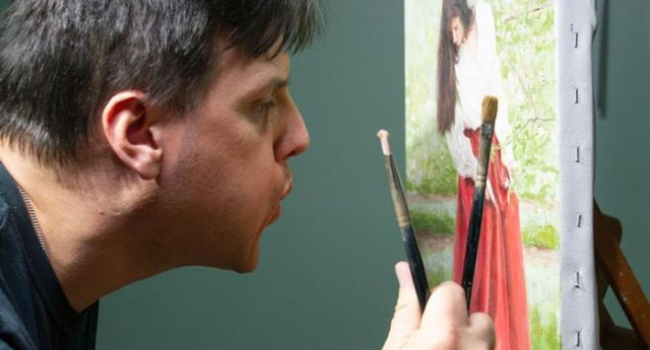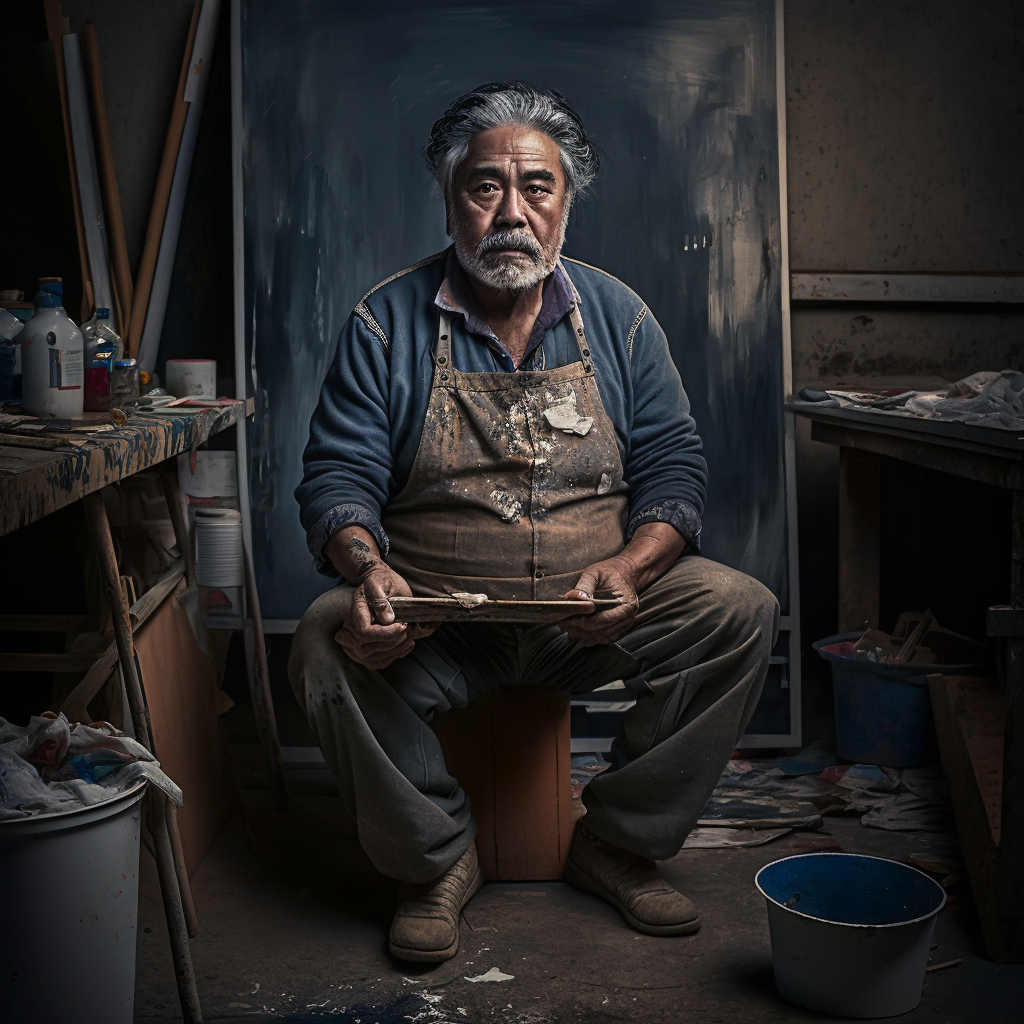Randy Charles is the owner of PaintCentric.com, a website dedicated to providing information, tips, tricks, and news about all things paint. With over 10 years...Read more
Oil painting? Want to know how long to wait for it to dry? Depends. On the type of paint, how thick it’s applied, and the environment. Let’s look at each factor in detail. How does it influence oil painting drying time? Let’s find out!

- Type of paint – different types of oil paints have varying drying times.
- Thickness – thicker layers of paint will take longer to dry than thinner layers.
- Environment – temperature and humidity can affect the drying time of oil paints.
Type of paint
The type of paint used can influence drying time. Generally, oil-based paints take much longer than acrylics or enamels. This is because oil-based paints contain solvents and binders of natural oils and liquid resins, which are harder to dry than water-based ones. The gloss of the finished painting affects drying time too. Flat/matte colors will take longer than glossy colors. Plus, if several layers of paint are applied, each layer must dry before the next layer. This can slow down the speed of an oil painting project.
Thickness of paint
The thickness of the paint or the amount of solvent used in the mix of your oil painting can have a huge impact on the dry time of your artwork. Thick coats take longer to dry as they need to be absorbed deeply. Oils need lots of time to soak into the painting surface and evaporate, so you must wait several months for them to dry fully.
Solvents in oil paint can influence its drying time. Some solvents are less volatile than others, making it hard for the work to dry fast. Selecting more driers and thinner paint can reduce drying times by half. A primer coating before the top coats will significantly reduce drying time.
Temperature and humidity
Temperature and humidity both affect how long an artwork takes to dry. Generally, the warmer and drier the environment, the faster it will dry. Hotter temperatures can lead to needing more coats of oil paint, making the drying time longer. High humidity levels can also cause longer drying times due to moisture in the air bonding with paint particles. This process is known as “humidity blooming.”
So when you paint, watch out for how temperature and humidity affect your artwork’s results and drying speed.
Average Drying Times
Oil paints call for patience – they take forever to dry. The drying time can differ depending on the paint type, the thickness of the paint, and the environment. Let’s explore the average drying times for oil paintings so that you can be prepared!
- Thin layers of paint should take around 24 hours to dry.
- Medium layers of paint should take around 48 hours to dry.
- Thick layers of paint should take around 72 hours to dry.
Oil paints
Oil paint is a popular medium for artists. Depending on the type and conditions, it can take days, months or even years to dry. Factors such as temperature, humidity, color application, airflow, and oil use play a role. Artist-grade colors take longer than student-grade colors due to the higher pigment content. The more paint layers, the longer it takes each layer to dry. Some mediums, like alkyds, dry faster, while others, like walnut oil, slow down the process.
Temperatures around 21-26°C with moderate humidity are ideal for speeding up drying times. However, during winter, artwork may not reach full curing until spring!
Acrylic paints
Acrylic paints offer many advantages over other types. They dry fast, like thin plastic, in minutes, not days. They come in different temperatures, from high-viscosity to lighter gels and inks that dry almost instantly. Thin layers dry in 15 minutes, and heavy layers in 10 hours.
To completely cure, the painting should have a sealed surface and be out of direct sunlight for 24-48 hours. After this period, the painting should be safe to transport. Still, it is best to protect it until it is fully dry and ready for display.
Watercolor paints
Watercolor paints are special as they contain both water and pigment. They are called “watercolor” because water activates the pigment and dries on its own when exposed to air. Generally, it takes hours or a day for watercolor painting to dry. But this depends on the thickness of the water or paint applied. If thick layers are used, it can take 24-48 hours to dry due to the high pigment density and slow evaporation rate. Thin layers of paint dry faster as less pigment is present, allowing faster evaporation.
Paper type can also affect the drying time. Some absorb more moisture than others, making them take longer to dry with all layers in place. High-quality paper like cold or hot-pressed paper is recommended, as it can hold multiple heavy layers when applying thick washes and still give a crisp finish when dry.
Lastly, some artists use oils or linseed oil in mediums or on wet washes. This slows the amount of moisture absorption, letting larger areas remain wet for longer before finally drying out naturally.
Techniques to Speed Up Drying Time

Oil painting is an art form that is both creative and rewarding. However, it can take a while for the painting to dry! Luckily, there are ways to speed up the drying time.
Use a fan
A fan is a great way to speed up the drying time of an oil painting. Get a small electric fan. Please put it in a dip in the wall or on a tabletop. It will blow hot air onto the canvas. This will help the oil evaporate faster. If your painting is large, get two fans. This will be more efficient. Regular circulation and fans work for two hours at a time.
Ensure your fan is at least an arm’s length away from the canvas. Too close, and it could damage or affect the texture of your paint.
Use a hairdryer
A hairdryer is a fast and useful way to dry your oil painting. Use it on low to medium heat, but don’t stay in one place too long. Angle the dryer slightly downwards, ensuring it’s 12 inches from the painting. After drying it, you can decide if more paint is needed. If it is, wait between 24-72 hours before continuing. This will ensure each layer adheres properly.
Use a heat gun
A heat gun can be used to speed up oil paint drying. It is a handheld electric fan that blows hot air on the painting. This increases circulation and helps the paint dry faster. Keep the temperature under 800⁰F or use short blasts to avoid overheating the paint. However, bubbles may form in thick applications of paint.
To reduce drying time, expose the painting to circulating air like fans and keep it in a warm room with good ventilation:
- Use a heat gun with temperatures under 800⁰F.
- Use short blasts to avoid overheating the paint.
- Expose the painting to circulating air-like fans.
- Keep it in a warm room with good ventilation.
-

Oil paint
Tips for Preventing Damage
Oil painting is a special kind of art. It can be time-consuming but rewarding once it’s finished. Be patient with the drying process! It is delicate and must be handled carefully.
Here are some tips to help you prevent any harm to your oil painting and ensure it dries properly:
- Keep your painting away from direct sunlight.
- Do not touch the painting while it is drying.
- Do not hang the painting until it is completely dry.
- Do not use a hair dryer to speed up the drying process.
- Keep the painting in a cool, dry place.
Refrain from touching the painting.
Touching an oil painting can cause serious damage. When oil paints dry, they form a hard film. Pressure on this can ruin the painting, making the pigment change shape. To reposition it, use cotton gloves and move with one finger.
Dust can be removed with a soft brush, like a toothbrush or cheesecloth. Turpentine or mineral spirits should only be used by trained frame conservators who know how these solvents will react to the painting.
Place the painting in a low-humidity environment.
Display your oil painting in a low-humidity atmosphere to avoid damage. Humidity may cause mold growth, discoloration, and even warping of the paint from moisture. Make sure the room with the painting has little moisture. Alternatively, use a dehumidifier.
To reduce humidity and protect your artwork, use a fan. This provides ventilation and lowers humidity where the painting is stored or hung.
Avoid using chemicals to speed up the drying process
Solvents like turpentine or mineral spirits can help manipulate and dry paint quickly. But be aware – these chemicals are highly flammable and can damage delicate surfaces. They should not be overused or used in a concentrated form.
To ensure oil paint dries in the appropriate amount of time without any harm, it is best to avoid using chemicals altogether. Depending on its thickness, oil paint typically needs several weeks to months to dry.
Frequently Asked Questions
How long does it take for an oil painting to dry?
It typically takes oil paints between 24 hours to 2 weeks to dry. The amount of time depends on the type of oil paint, the paint’s thickness and the room’s climate.
What is the best way to speed up the drying process of an oil painting?
The best way to speed up the drying process is to use a fan or hairdryer to circulate air around the painting. You can also use a heat lamp or oil painting drying medium to help speed up the process.
Is it safe to varnish an oil painting that isn’t completely dry?
A3:No, it is not recommended to varnish an oil painting that is not completely dry. Varnishing an oil painting before it is completely dry can cause the colors to shift and the paint to crack. It is best to wait for the painting to dry before varnishing.

Randy Charles is the owner of PaintCentric.com, a website dedicated to providing information, tips, tricks, and news about all things paint. With over 10 years of experience in the painting industry, Randy has become an expert in the field and is passionate about helping others learn more about painting. He has written numerous articles on the subject and is committed to providing accurate and up-to-date information to his readers.
- Latest Posts by Randy Charles
-
How Much Do You Tip Painters? The Ultimate Guide
- -
Can You Paint Over Rust Converter?
- -
Can You Paint Inside When It Is Raining?
- All Posts
